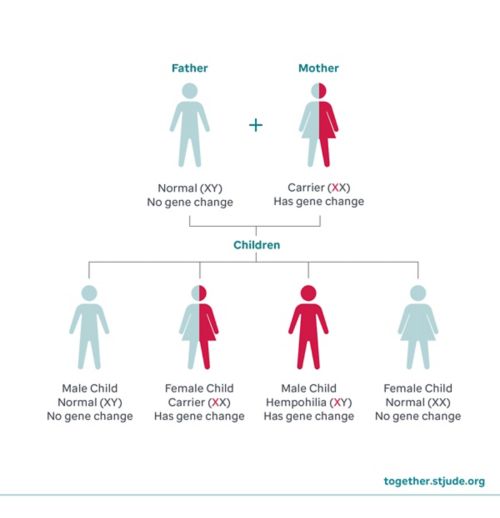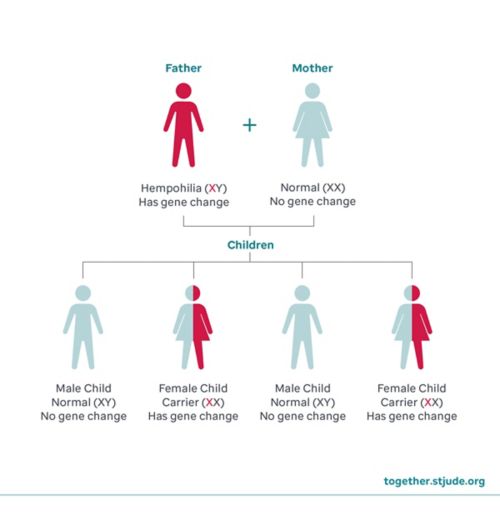If your child is diagnosed with hemophilia, they will be treated by a hematologist, a doctor who specializes in treating blood disorders.
Treatment for hemophilia is based on disease severity, the child’s activity level, and medical or dental procedures needed. Current therapies include:
Clotting factor replacement therapy
Replacement therapy is the main treatment for hemophilia. This treatment replaces the clotting factor that is low or missing in the blood.
Clotting factor medicines for replacement therapy can be made from the plasma of donated blood (plasma factor concentrate). Plasma is the part of the blood that has clotting proteins. Clotting factors for replacement therapy can also be man-made concentrates called recombinant clotting factors.
Replacement therapy for hemophilia is given in a vein by IV and can be given at a medical clinic or at home by a trained caregiver. After the clotting factor is given, it works quickly to increase the factor levels.
- Factor VIII (8) products include: ADVATE®, ELOCTATE®, ALPHANTE®, NUWIQ®
- Factor IX (9) products include: BeneFIX®, ALPROLIX®, IDELVION®
Treatment with factor products may be given either preventatively (called prophylaxis or prophy) or as needed for bleeding symptoms as they occur. The decision to start prophylaxis is made between the hematologist and the family. However, research has shown that children with hemophilia who were treated regularly to prevent bleeding had less joint damage by age 6 than did children who were only treated after a bleed started.
Subcutaneous novel therapy
Emicizumab (HEMLIBRA®) is a medicine used to help prevent bleeding events in patients with hemophilia A, a factor VIII (8) hemophilia. Emicizumab mimics the role of factor VIII (8) and helps the blood to clot.
Since emicizumab is not actual factor VIII (8), it works even in patients with inhibitors. Emicizumab is given as an injection under the skin once a week, every other week, or every 4 weeks to prevent bleeding.
This medicine is used for prevention only. It should not be used to treat an active bleed. It will only work in factor VIII (8) hemophilia and not factor IX (9). If bleeding events occur, the patient needs to infuse factor VIII (8) concentrate (or Factor VIIa in the case of inhibitor) to treat the bleed.
Desmopressin acetate (DDVAP)
DDVAP is a man-made hormone used to treat some people with mild hemophilia A. It is not used to treat hemophilia B or severe hemophilia.
DDAVP causes the release of von Willebrand factor from where it is stored in the lining of the blood vessels and in platelets. Von Willebrand factor is bound to factor VIII (8) in the blood. Without von Willebrand factor, factor VIII (8) is destroyed quickly. Because it is bound to factor VIII (8), von Willebrand factor increases the amount of the clotting factor VIII (8) in the blood.
Treatment with DDAVP is only given in certain situations, such as before a dental procedure to help reduce or prevent bleeding. If used often, this medicine will not work as well.
Some people do not have a good increase in their factor VIII (8) levels with DDAVP. To see if your child will have a good response, your care team may order a DDAVP challenge. This will measure the amount of factor VIII (8) in the blood before and after being given the medicine.
Antifibrinolytic medicines
Antifibrinolytic medicines are used to help keep blood clots together once they are formed. These medicines include tranexamic acid (Lysteda®) and aminocaproic acid (Amicar®).
Antifibrinolytic medicines may sometimes be used along with clotting factor replacement therapy or DDAVP. These medicines are usually taken before and after a dental procedure. They are used to stop bleeding from the mouth or nose or to treat heavy menstrual cycles.
Gene therapy
Scientists are studying new gene therapy treatments for hemophilia. Gene therapies work by changing or repairing genes to correct the genes that cause hemophilia. Researchers continue to test gene therapy in clinical trials to find ways to prevent or reduce bleeding in people with hemophilia.
- Studies are underway to develop a method of inserting more useful clotting factors into the cells of people with hemophilia for better blood clotting.
- Researchers are also focusing on gene therapy that may help people with hemophilia to begin producing clotting factors normally. This might reduce or remove the need for regular replacement therapy.





